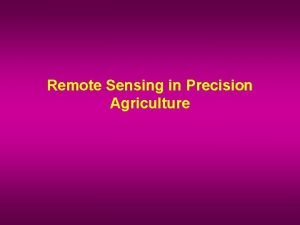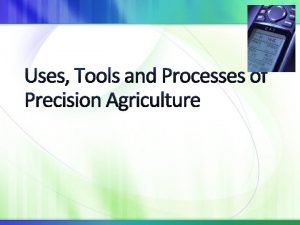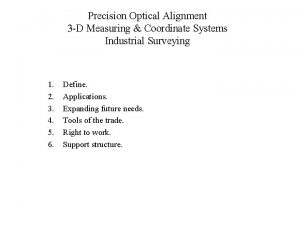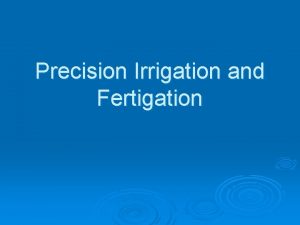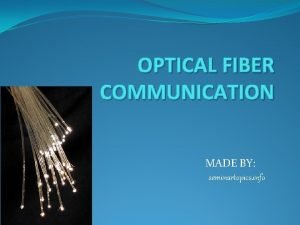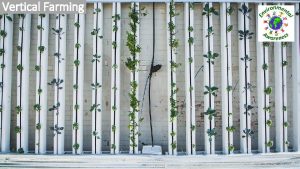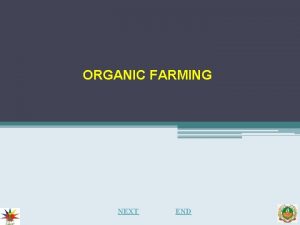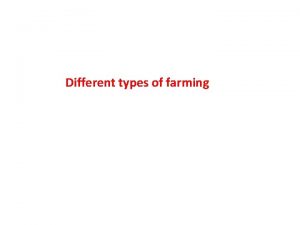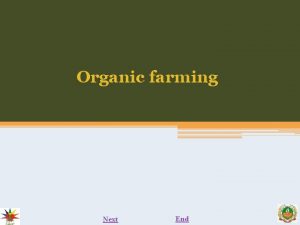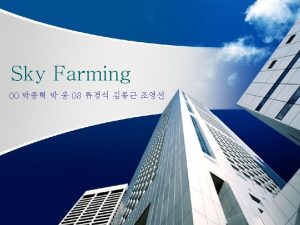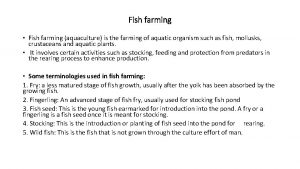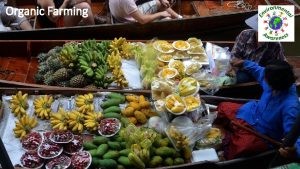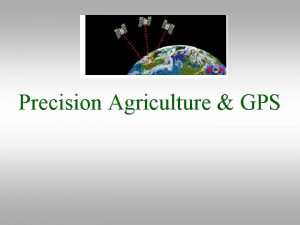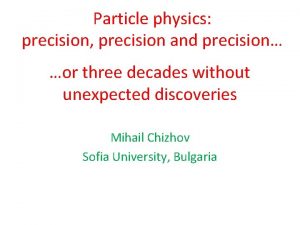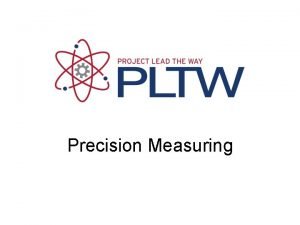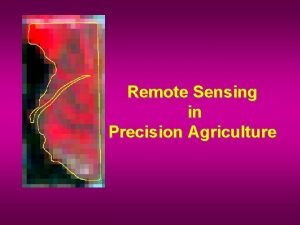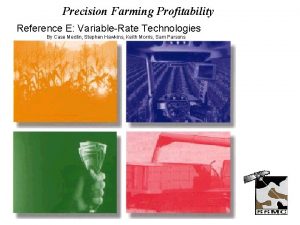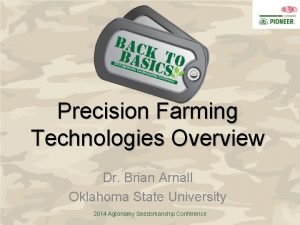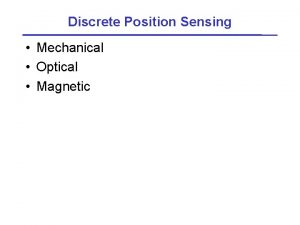Sensing technologies for precision Farming Application of optical




















































- Slides: 52

Sensing technologies for precision Farming Application of optical sensors 1/30/2004 SOIL/BAE 4213 1 of 50

Optical sensing in Precision Farming (Techniques) l Aerial remote sensing • Film (visible/NIR/IR) and digitization • Direct Digital recording l Field machine based remote sensing • Direct Digital recording l Manual crop survey methods • Direct Digital (manual recording /logging) 1/30/2004 SOIL/BAE 4213 2

Purpose for use of optical sensing in Precision Farming l Used to characterize plant or soil status • Requirement: Calibration of spectral parameters to status l Used to characterize boundaries – Physical – Morphological • Requirement: Accurate spatial calibration (1 m actual = 1 pixel) Lat/Lon = f(pixel position) 1/30/2004 SOIL/BAE 4213 3

Issues in conducting remote sensing – Variability in light source – Filtering of light along path – Measuring units/calibration of sensing system – Geometry – Spatial and temporal frequency of measurements 1/30/2004 SOIL/BAE 4213 4

Typical Multi-Spectral Sensor Construction One Spectral Channel CPU Photo-Diode detector / Amplifier Analog to Digital Converter Optical Filter Illumination Collimator Radiometer Computer Target 1/30/2004 SOIL/BAE 4213 5

Fiber-Optic Spectrometer One Spectral Channel at a time Optical Grating Analog to Digital Converter CPU Optical Glass Fiber Element selection Computer 1/30/2004 Photo Diode Array SOIL/BAE 4213 6

Fundamentals of Light l Light = Energy (radiant energy) – Readily converted to heat • Light shining on a surface heats the surface • Heat = energy l Light = Electro-magnetic phenomena – Has the characteristics of electromagnetic waves (eg. radio waves) – Also behaves like particles (e. g. . photons) 1/30/2004 SOIL/BAE 4213 7

Relationship between frequency and wavelength l Plus Minus 1/30/2004 Minus SOIL/BAE 4213 8

Relationship between frequency and wavelength Wavelength = speed of light divided by frequency (miles between bumps = miles per hour / bumps per hour) 1/30/2004 SOIL/BAE 4213 9

Relationship between frequency and wavelength l Plus Antenna Plus Minus 1/30/2004 + - Minus SOIL/BAE 4213 l KOSU = 3 x 108 / 91. 7 x 106 l KOSU = 3. 3 m l red = 6. 40 x 10 - 7 m = 640 nm Bohr’s Hydrogen = 5 x 10 - 11 m 10

Light Harvesting structure - model Jungas et. al. 1999 1/30/2004 SOIL/BAE 4213 11

Light emission / absorption governed by quantum effects Planck - 1900 DE n h n 1/30/2004 Einstein - 1905 is light energy flux is an integer (quantum) is Planck’s constant is frequency SOIL/BAE 4213 One “photon” 12

Changes in energy states of matter are quantitized Bohr - 1913 Where Ek, Ej are energy states (electron shell states etc. ) and frequency, n , is proportional to a change of state l and hence color of light. Bohr explained the emission spectrum of hydrogen. l Hydrogen Emission Spectra (partial representation) Wavelength 1/30/2004 SOIL/BAE 4213 13

Photo-Chemistry l Light may be absorbed and participate (drive) a chemical reaction. Example: Photosynthesis in plants The wavelength must be correct to be absorbed by some participant(s) in the reaction l Some structure must be present to allow the reaction to occur l Chlorophyll l Plant physical and chemical structure l 1/30/2004 SOIL/BAE 4213 14

Visual reception of color Receptors in our eyes are tuned to particular photon energies (hn) l Discrimination of color depends on a mix of different receptors l Visual sensitivity is typically from wavelengths of ~350 nm (violet) to ~760 nm (red) l Wavelength 400 nm 1/30/2004 500 nm SOIL/BAE 4213 700 nm 15

Silicon Responsivity 1/30/2004 SOIL/BAE 4213 16

Primary and secondary absorbers in plants l Primary – Chlorophyll-a – Chlorophyll-b l Secondary – Carotenoids – Phycobilins – Anthocyanins 1/30/2004 SOIL/BAE 4213 17

Chlorophyll absorbance Chla: black Chlb: red BChla: magenta BChlb: orange BChlc: cyan BChld: bue BChle: green Source: Frigaard et al. (1996), FEMS Microbiol. Ecol. 20: 69 -77 1/30/2004 SOIL/BAE 4213 18

Radiation Energy Balance Incoming radiation interacts with an object and may follow three exit paths: • Reflection • Absorption • Transmission a + t + r = 1. 0 a, t, and r are the Il 0 Il r 0 Il a 0 I t l 0 fractions taking each path Known as absorbance, transmittance, reflectance respectively 1/30/2004 SOIL/BAE 4213 19

Nature of absorption by the atmosphere Transmitted Reflected Incident Absorbed Earth's surface 1/30/2004 Atmosphere Radiant energy balance must be computed for each component of the atmosphere and for each wavelength to estimate the radiation incident on the earth's surface SOIL/BAE 4213 20

Reflectance – Ratio of incoming to reflected irradiance – Incoming can be measured using a “white” reflectance target – Reflectance is not a function of incoming irradiance level or spectral content, but of target characteristics 1/30/2004 SOIL/BAE 4213 21

Solar Irradiance NIR UV 1/30/2004 SOIL/BAE 4213 22

Absorption of Visible Light by Photopigments Sunlight Chlorophyll b Absorption Phycocyanin B-Carotene Chlorophyll a 300 400 500 600 700 800 Wavelength, nm Lehninger, Nelson and Cox 1/30/2004 SOIL/BAE 4213 23

Reflectance (%) 0. 5 Visible Near Infrared 0. 25 Plant Reflectance 0. 00 450 500 550 600 650 700 750 800 850 900 950 1000 1050 1100 1150 Wavelength (nm) 1/30/2004 SOIL/BAE 4213 24

Spectral response to Nitrogen 1/30/2004 SOIL/BAE 4213 25

Soil and crop reflectance 1/30/2004 SOIL/BAE 4213 26

Interfering Inputs: Soil Reflectances - Oklahoma 1/30/2004 SOIL/BAE 4213 27

Soil Reflectances - Oklahoma 1/30/2004 SOIL/BAE 4213 28

Thermal or Infrared imaging l Nature of the Emission of Radiation – Black-body radiation • Matter is made up of inter-related particles which may be considered to vibrate or change energy state • A distribution of energy states exists within a blackbody • Matter emits radiation in proportion to the energy state changes – Warm matter emits radiation • You can feel the radiated energy from a hot poker • Colder bodies also emit, just at a lower level 1/30/2004 SOIL/BAE 4213 29

Sun vs. Plant / Soil radiation SUN 6000 K Thermal radiation Terrestrial 300 K 1/30/2004 SOIL/BAE 4213 30

Infrared Image example GER Corporation 1/30/2004 SOIL/BAE 4213 31

Sensor-Based Nitrogen Management Variable Rate Nozzle system Decision Making And Agronomic Strategy Computer and Sensor Assembly Direction of Travel Plant 1/30/2004 SOIL/BAE 4213 32

NDVI - Normalized Difference Vegetative Index Developed as an irradiance Index for remote sensing l Varies from -1 to 1 l • Soil NDVI = -0. 05 to. 05 • Plant NDVI = 0. 6 to 0. 9 • Typical plants with soil background NDVI=0. 3 -0. 8 l NDVI from different sources vary – Bandwidths for Red, NIR vary – Irradiance vs. reflectance based l Properties • Difference increases with greater red absorption • Increase or decrease in total irradiance does not effect NDVI • Typically computed with irradiances, use of reflectance eliminates spectral shift sensitivity 1/30/2004 SOIL/BAE 4213 33

Irradiance Indices Based on ratios of reflected Red and NIR intensity Example Index: Rred / Rnir Spectral shift in illumination prevents use of simple irradiance sensing 1/30/2004 SOIL/BAE 4213 34

OSU Irradiance ratio sensor 1/30/2004 SOIL/BAE 4213 35

Reflectance Indices Based on ratios of Red and NIR Reflectance Red Reflectance: rred = Rred / Ired NIR Reflectance: rnir = Rred / Ired Index: Reflectance is primarily a function of target 1/30/2004 SOIL/BAE 4213 36

OSU Reflectance Sensor 1/30/2004 SOIL/BAE 4213 37

OSU Reflectance Sensor l l l 1/30/2004 Natural Illumination Battery powered Wide dynamic range Low noise 0. 75 x 0. 25 m field of view SOIL/BAE 4213 38

Self contained illumination (NTech) 1/30/2004 SOIL/BAE 4213 39

Sensor Function 1/30/2004 SOIL/BAE 4213 40

Sensor-Based Variable Rate Top-Dress Fertilizer Concept: (OSU wheat) Plant spectral reflectance in red and NIR bands are used to measure nitrogen uptake and estimate crop yield l Plant is an indicator of availability of nutrients, germination levels, previous environment, insect damage, etc. l Application rate determined based on estimated yield and response index l 1/30/2004 SOIL/BAE 4213 41

In-Season Response Index (RINDVI) Non-N Limiting 1/30/2004 Farmer Practice SOIL/BAE 4213 42

Green. Seeker. TM N-Fertilizer Handheld Optical Sensor The same active lighting optical sensor used on the variable rate fertilizer applicator l Optically measures plant biomass, total nitrogen in the crop, and plant stress l Can sample scan a wheat field (or other crop) l Data can use to calculated response index for added nitrogen fertilizer l 1/30/2004 SOIL/BAE 4213 43

Yield Estimation: (modeling growth in wheat) Stem Extension Heading Ripening Stage Tillering 1/30/2004 SOIL/BAE 4213 44

Yield Estimation INSEY vs Grain Yield (24 locations, 1998 -2001) 1/30/2004 SOIL/BAE 4213 45

Role of RI in Yield Estimation Estimates yield with added N 3 2. 5 y = 1. 06 x + 0. 18 R 2 = 0. 56 2 1998 RI Harvest 1999 1. 5 2000 2001 1 0. 5 0 0 1/30/2004 0. 5 1 1. 5 RI NDVI SOIL/BAE 4213 2 2. 5 3 46

Yield Estimation with Fertilizer (OSU wheat) Farmer Selected YPMAX YPN (RI=2. 0) YPN (RI=1. 5) YP 0 1/30/2004 SOIL/BAE 4213 47

N Fertilization Rate Algorithm (OSU wheat) 1/30/2004 SOIL/BAE 4213 48

Implementation of Sensor-Based Variable Rate Nitrogen Application 1/30/2004 SOIL/BAE 4213 49

GREENSEEKERTM Applicator l l l l Sense and treat each 2 ft by 2 ft area Applies one of seven fertilizer rates based on the crops yield potential Up to 15 mph machine speed Day or night operation Provide the capability to detect and treat other plant problems Record and georeference sensor data for GIS analysis Sense and spot spray weeds (current Patchen technology) 1/30/2004 SOIL/BAE 4213 50

Tri-valve Set for Varying Rate l 8 Stepped rates Valve – OFF to 7 x l Treats 24”x 24” area applying the target rate on 85% of that area 1/30/2004 Rate 1 x 2 x 4 x Total 0 0 1 0 2 1 2 0 3 0 0 4 4 1 0 4 5 0 2 4 6 1 2 4 7 SOIL/BAE 4213 1 x 2 x 4 x 51

Summary of Results - 10 Field Trials Green. Seeker. TM Field Sprayer (OSU Wheat) Treatment Pre-Trt. N, lb/ac Total N, lb/ac Yield, lb/ac Net Rtn, $/ac N-Rich Strip 94 0 94 44. 6 110 Var. Rate 56 23 79 39. 8 100 Fixed Rate A 56 35 91 37. 3 91 Fixed Rate B 58 24 82 35. 4 85 Field Rate 73 20 92 34. 6 82 SED 3. 1 9. 5 Treated March 20 to April 10, 2002 Net Revenue = grain yield * $3. 00 / bu – N Fertilizer * $0. 25 / lb SED = Standard Error of the Difference 1/30/2004 SOIL/BAE 4213 52
 Remote sensing in precision agriculture
Remote sensing in precision agriculture Define precision farming
Define precision farming Non precision instruments
Non precision instruments Precision vs semi precision attachment
Precision vs semi precision attachment Single precision vs double precision
Single precision vs double precision Precision optical blanks
Precision optical blanks Precision optical alignment service
Precision optical alignment service Low energy precision application
Low energy precision application Uses of optical fibres in medicine
Uses of optical fibres in medicine Bo bergman jag fryser om dina händer
Bo bergman jag fryser om dina händer Kanaans land
Kanaans land Skivepiteldysplasi
Skivepiteldysplasi Tack för att ni lyssnade bild
Tack för att ni lyssnade bild Strategi för svensk viltförvaltning
Strategi för svensk viltförvaltning Romarriket tidslinje
Romarriket tidslinje Informationskartläggning
Informationskartläggning Tack för att ni har lyssnat
Tack för att ni har lyssnat Vad står k.r.å.k.a.n för
Vad står k.r.å.k.a.n för Cks
Cks Läkarutlåtande för livränta
Läkarutlåtande för livränta Vishnuismen
Vishnuismen Inköpsprocessen steg för steg
Inköpsprocessen steg för steg Påbyggnader för flakfordon
Påbyggnader för flakfordon Egg för emanuel
Egg för emanuel A gastrica
A gastrica Varians formel
Varians formel Rutin för avvikelsehantering
Rutin för avvikelsehantering Myndigheten för delaktighet
Myndigheten för delaktighet Presentera för publik crossboss
Presentera för publik crossboss Fspos
Fspos Treserva lathund
Treserva lathund Tack för att ni lyssnade
Tack för att ni lyssnade Hur skriver man en tes
Hur skriver man en tes Var 1721 för stormaktssverige
Var 1721 för stormaktssverige Tobinskatten för och nackdelar
Tobinskatten för och nackdelar Mall för referat
Mall för referat Atmosfr
Atmosfr Vad är vanlig celldelning
Vad är vanlig celldelning Varför kallas perioden 1918-1939 för mellankrigstiden
Varför kallas perioden 1918-1939 för mellankrigstiden Programskede byggprocessen
Programskede byggprocessen Karttecken kraftledning
Karttecken kraftledning Rbk fuktmätning
Rbk fuktmätning Kraft per area
Kraft per area Elektronik för barn
Elektronik för barn Vad är densitet
Vad är densitet Tack för att ni har lyssnat
Tack för att ni har lyssnat Smärtskolan kunskap för livet
Smärtskolan kunskap för livet Frgar
Frgar Argument för teckenspråk som minoritetsspråk
Argument för teckenspråk som minoritetsspråk Typiska drag för en novell
Typiska drag för en novell Luftstrupen för medicinare
Luftstrupen för medicinare Multiplikation med uppställning
Multiplikation med uppställning Delegerande ledarstil
Delegerande ledarstil
